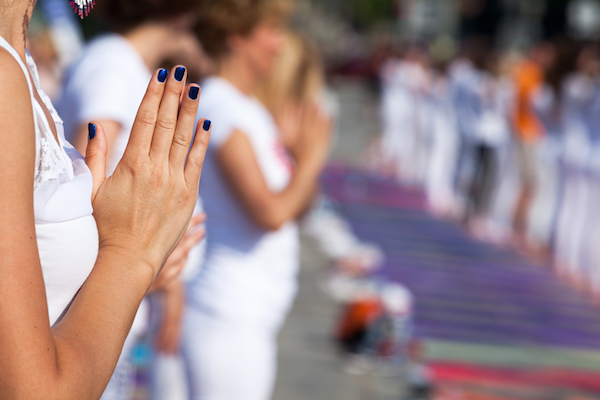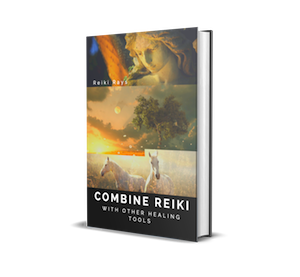Isshinryu is a martial art founded by Tatsuo Shimabuku on the island of Okinawa in 1956. Shimabuku created Isshinryu after studying several other styles of karate which were heavily influenced by older Chinese martial arts.
While Shimabuku introduced many new martial concepts into his Isshinryu system such as the vertical fist, he also incorporated esoteric Buddhist teachings known as Vajramukti which contain many teachings like those found in Reiki that emphasize self-healing, healing others, and spiritual development.
As they learn Isshinryu karate, students practice the basic techniques of kicking, punching, and blocking. Practitioners also learn kata which are choreographed patterns of movements that teach the practical application of basic techniques previously learned. Hidden within several Isshinryu katas are energic patterns placed there by Shimabuku to stimulate the flow of ki and strengthen the physical body and internal chakra system. Shimabuku also taught that one’s internal energy, or ki, could be trained to influence the energy field of another up close or from a distance like a Reiki healing session which can be performed in person or remotely.
Supporting this, Isshinryu historian Hayashi Tomio has stated that “we are, at any given time and by degrees, in constant communication with our many extensions.” 1
During my sophomore year of college, I was fortunate to have studied Isshinryu karate with Harold Mitchum who was an 8th degree black belt in Isshinryu and one of four prominent U.S. Marines to study directly with Shimabuku while stationed on Okinawa. These four individuals later brought Isshinryu karate back to the United States and opened their own schools after their tours of duty on Okinawa ended. Although I did not make the connection between Reiki and Isshinryu at the time, I would later realize the benefits of combining many of the concepts from both arts.
During my training with Sensei Mitchum, I became friends with his assistant instructor who everyone knew as “Gunny.” In the U.S. Marine Corps, Gunny is a nickname used for those who have achieved the rank of Gunnery Sergeant. As it turned out, Gunny trained with Mitchum occasionally while stationed on Okinawa but not directly with Shimabuku. Instead, Gunny trained at Futenma Air Station on Okinawa with Shigema Genyu who Shimabuku had designated his assistant instructor because he spoke fluent English. Shigema also worked in the Marine Corps cafeteria at Camp Courtney on Okinawa where Gunny ate most of his meals and where the two became close friends.
According to Shigema, a practitioner of the martial arts could obtain the highest skill level by developing and tuning into the Ki frequencies imbedded by Shimabuku into his Isshinryu system. However, the knowledge of how to accomplish this was usually reserved for natives of Okinawa and not transmitted to the Americans studying there. Fortunately, Gunny was taught many of these skills by his close friend Shigema who once related that martial arts should not be used for fighting, but rather to achieve what he termed An-shin-ritu-mi, a state of perpetual personal peace.
Shigema Sensei also taught a system of healing to his students known as G-Jo (pronounced Jee-Joe) which is similar to Reiki, but also uses the fingers in addition to the palms of the hands to stimulate acupressure points on the body. Still in use today, G-Jo “comes from the Chinese characters meaning ‘emergency first aid’ and by merely applying this simple method you can heal common aliments such as headaches, indigestion, sprains and more, literally within seconds.” 2
I was fortunate to learn both Isshinryu and G-Jo from Gunny.
Gunny’s brother learned Reiki in Hawaii while serving in the Navy, and their shared opinion was the Ki energy used in G-Jo was the same universal energy in Reiki and that G-Jo might have been a form of Reiki that migrated from mainland Japan to the island of Okinawa. Like Reiki, G-Jo is performed by applying the hands to various locations on the body. While it was used on Okinawa mainly to provide relief from common ailments such as headaches and indigestion, it was also used by martial artists to speed healing from bruises and injuries acquired during practice just as Usui Sensei used Reiki to heal his injured toe on Mt. Kurama.

The Synthesis of G-Jo and Reiki
At that time in my life, I had no idea what Reiki was but I was familiar with the concept of Ki from my participation in other martial arts, specifically Aikido. Years later I would become a Reiki Master. It was then that I discovered the benefit of merging elements of Reiki and G-Jo during my healing sessions and also integrating Reiki into my practice of Isshinryu. I have respectively termed this combination G-Jo Reiki since it has been said that “with the channeling of other healing methods similar to Usui Reiki Ryoho but with different vibrations and effects, it has become clear that there is a whole class of healing methods that can be appropriately called Reiki. There are now over 30 different kinds of Reiki with many subgroups and branches.” 3
While G-Jo Reiki uses light palm pressure on the areas being treated to activate healing, I found not touching the body at all yielded the same result. More important than touch or no touch was acquiring the ability to feel the flow of energy between the hands and bodily locations during a G-Jo Reiki treatment. These G-Jo Reiki points are located on energy meridians within the body and are correlated to the location of acupuncture points and chakras. Since these points govern large areas of the body and may overlap, stimulating any one of these areas can produce healing benefits and may decrease inflammation in surrounding tissues.
The six basic G-Jo Reiki points on the body are:
- Point 1 – located in the middle of the forehead just above the eyes which corresponds to the Third Eye Chakra. Applying G-Jo Reiki to this point while meditating can help to awaken one’s third eye or spiritual center. Gunny stated that students on Okinawa would often perform Isshinryu katas with accuracy while blindfolded after developing their Third Eye Chakra in this manner.
- Point 2 – at the throat where the collar bones merge. This point is associated with the Throat Chakra. Stimulating this point can help with issues of confidence, sore throat and ulcers in the mouth.
- Point 3 – at the Solar Plexus Chakra. Stimulating this point can help with indigestion, allergies and fatigue.
- Point 4 – about one inch below the navel near the Sacral Chakra. Treatment of this point helps with back pain, joint problems and overactive kidneys.
- Point 5 – on the inside of the arm about two inches from the crease of the wrist and in line with the middle finger. Applying pressure here helps with nausea and pain from sore chest muscles.
- Point 6 – about three inches above the ankle on the inside of the leg. Stimulating this area is helpful in treating ankle sprains, leg bruises and stomach aches.
Since each of these points overlap, tracing the Reiki symbols over these basic points as they are sequentially encountered during a G-Jo Reiki session can increase the effectiveness of the treatment. Just as in my Reiki practice, I start at the head or crown area, trace the Reiki symbols before working my way down the left side of the body. I pause at each of the points to scan the body and trace one or more of the Reiki symbols at each site if I sense they are needed. G-Jo Reiki is also helpful in guiding beginning practitioners in hand placement and strengthening Byosen scanning abilities by making the hands more sensitive and perceptive.
Gunny related stories of how Isshinryu students were healed of bruises on their arms and legs by the use of these points, and how the pain of a sprained ankle he experienced when his foot was swept out from under him during practice was relieved after several treatments to the ankle point.
Reiki, Chinkuchi, and Isshinryu
In pre-World War II Okinawa, martial arts masters also practiced a form of internal energy management known as Chinkuchi.
During the development of Isshinryu, Simabuku incorporated many Chinkuchi principles into his style in both the development of his katas and in the placement of the legs and hands during practice. He believed that directing the energy flow in the body using intention in combination with the use of certain leg and hand postures would create a positive energy flow through the chakras.
During my Reiki training, we practiced in socks or bare feet. This aligns with the Chinkuchi philosophy that our feet ground us to the Earth, and that the wearing of shoes restricts the body’s subtle energy flow. Additionally, Chinkuchi teaches that even wearing synthetic clothing material such as polyester blends cause energy channels in the body to constrict. I’ve found wearing natural cotton clothing while performing Reiki and Isshinryu enhances my perception of the energy flow throughout my body.
Isshinryu Stances and Reiki
Open any book on Reiki and one can usually find diagrams cataloging the various hand positions used to conduct a Reiki self-healing. Little information exists concerning the placement of the legs and feet during a self-healing or a full Reiki healing session.
Many of the katas, or forms practiced by Isshinryu students, place great emphasis on the placement of the legs and feet in order to optimize a grounding with the earth to ensure an unobstructed flow of energy throughout the body. I found incorporating an Isshinryu posture called Naihanchi Dachi into a Reiki practice is helpful in maintaining an enhanced energy flow. To support this, Reiki Master Jill Thiel has stated “martial arts stances, for example, from tai chi, are very effective for keeping good alignment when giving Reiki. Two stances especially useful for practitioners are the forward-leaning or bow and arrow stance and the side-side or horse-riding stance. The horse stance is used when facing the table directly. Both feet face the table with the head and back in alignment. The knees are bent equally to lower the body into position.” 4
While it resembles the horse-riding stance, Naihanchi Dachi stance is more relaxed with the legs and feet positioned shoulder width apart and the knees slightly bent which generates a small amount of tension within the thighs and legs.
Isshinryu teaches that assuming the Naihanchi Dachi stance strengthens the electromagnetic field around the body since our legs and feet form “energy taproots” which extend beyond the body into the Earth. The slight tension generated by standing in Naihanchi stance with the knees slightly bent engages and keeps Ki channels open which allows access to deeper energy levels that have been stored within the body awaiting release.
Isshinryu students would often assume a yoga Sukhasana pose, or easy sitting posture after performing a Naihanchi kata session and move their hands slowly over the body while pausing them momentarily at the G-Jo points much like someone performing a Reiki self-healing. Since this procedure can be performed in much less time than a full-blown Reiki self-treatment, elements from both can be combined to achieve accelerated health benefits.
During my years of Reiki and Isshinryu practice, I began to realize it felt natural to combine several aspects of both arts. This could be because Usui Sensei “had deep roots in the martial arts. From the age of a young boy he was trained as a samurai, learning Aiki Ju Jitsu, and it is speculated that he personally knew Morihei Ueshiba, the founder of the martial art of Aikido who also trained in Aiki Ju Jitsu.” 5
Since the Okinawan people were known to develop their own arts, which differed somewhat from those practiced in Japan, it is easy to understand how Reiki, which originated on mainland Japan, could have migrated to the island of Okinawa where it became known initially as G-Jo and was later incorporated into the Isshinryu karate system by Sensei Shimabuku.
However this happened, we are fortunate today to have both Reiki and Isshinryu to help us refine our healing skills and maintain optimal health!
Endnotes
- Hayashi Tomio, Internal Karate (Wind School Press, 2014), 51.
- Michael Blate, “Acupressure: The Healing side of the Martial Arts,” Black Belt Magazine, January 1996, 102-106.
- William Lee Rand, “Many Kinds of Reiki,” www.reiki.org, accessed March 5, 2024.
- Jill Thiel, “Better Body Mechanics in Reiki,” mnreikicenter.com/category/articles, accessed March 13, 2024.
- Tracy Warrener, “The Relationship of the Martial Arts and Reiki,” www.warrenerentertainment.com, March 17, 2017.
Article by Charlie Hall Felts
Free eBook download: We’ve created an eBook with our best articles on this topic, and offer it for free to all our newsletter subscribers.

Charlie is a Usui Holy Fire II Reiki Master and has a Bachelor of Science degree in Psychology from Georgia Southwestern State University and a Ph.D. in Esoteric Healing from the Esoteric Theological Seminary. He currently holds a black belt in the Korean art of Taekwondo. Charlie lives on the Emerald Coast in Florida with his wife and their two Shih Tzus. You may contact him by email at [email protected].





Leave a Reply